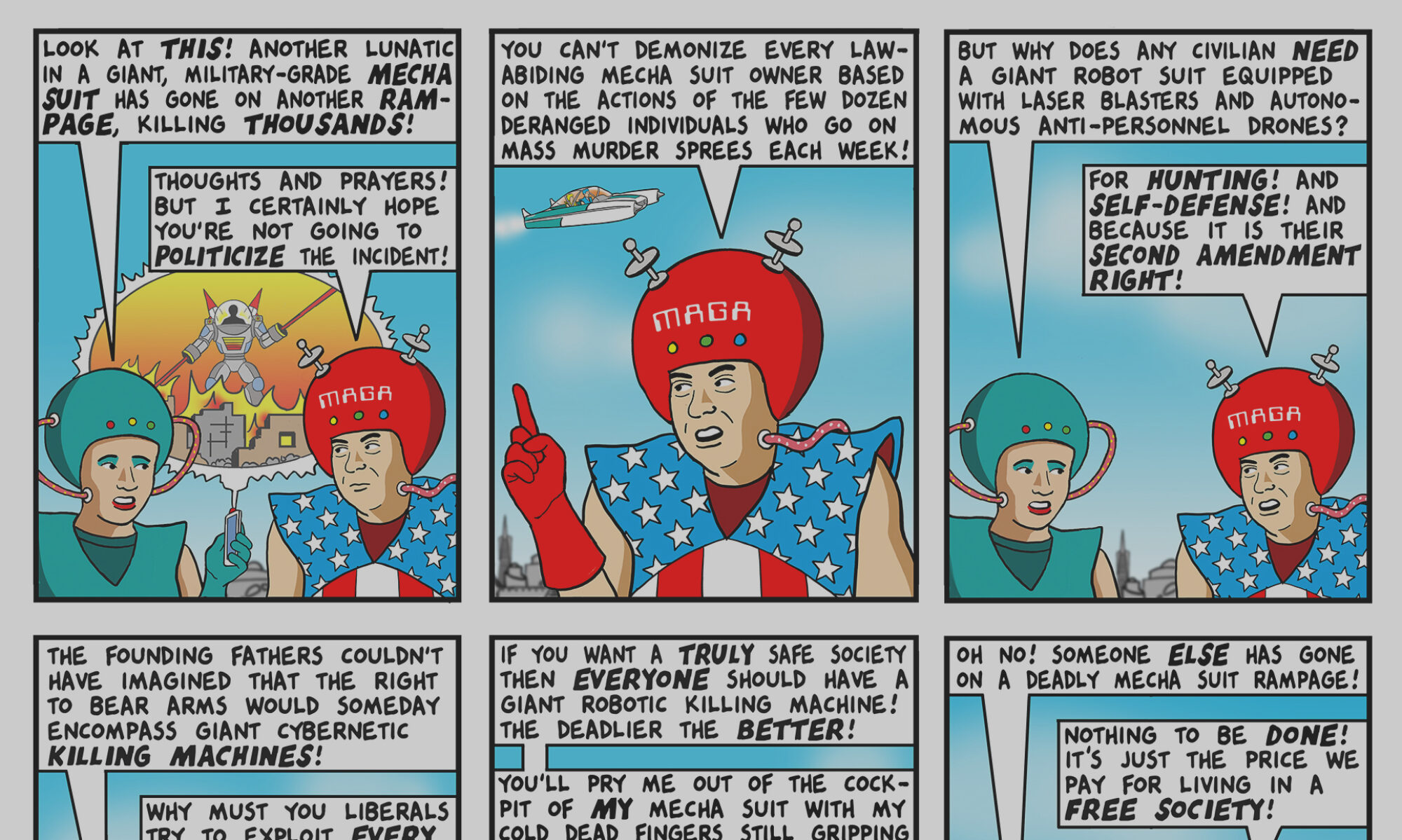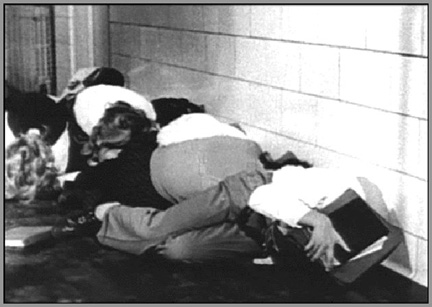In recent months, I’ve contemplated Hugh Hewitt’s description of “exaggeration, invective, (and) anonymous sources” as tactics “exclusive to the left”; read the cranky seventh-tier blogger ramblings of Maureen Dowd’s brother, and winced repeatedly at the ongoing mystery that is David Brooks. And I’ve wondered if there’s anything the editors of the New York Times op-ed page would find too objectionable to publish.
Well, now I have my answer.
But let us start at the beginning.
I was contacted by the art director of the op-ed page about a month ago — they were planning to devote a week to cartoons in early January, featuring a different artist each day, and wanted to invite me to submit a piece.
Now, the thing is, I’ve been down this road a number of times. And this is how it always plays out: a well-meaning art director contacts me. I submit a “rough” (which in my case means a completely written cartoon with roughly sketched in art, but since the writing is the hardest part, there’s no way I’m getting anywhere near compensated for my time unless the piece runs — which is why I almost never accept work when the words “kill fee” are involved). Even though I am given the impression of a very tight deadline, I won’t hear back for several days, possibly longer — which will leave me obsessively checking my email and mentally juggling my schedule. Then, after the well-meaning art director finally gets a chance to consult with the page’s editors, he or she will come back to me with the inevitable requests for “minor changes” which will somehow undermine, if not completely eviscerate, the integrity of the piece.
That’s just how it always goes. There are few things in life less certain. You can take it to the bank, use it as collateral on a six figure loan.
One quick example: I once had to rewrite a cartoon for the Times because the editor did not understand the meaning of the punchline, “do you want fries with that?”
I kid you not.
It’s not always quite that bad, but it’s never easy. My wife thinks it’s because they simply don’t understand what I do. They know how to edit columns and essays. They understand opening paragraphs, thesis statements, word counts, stylebook requirements, etc. But when it comes to cartoons, especially the kind of cartoons I do, in which the meaning of the thing lies in some nebulous space between words and art, as delicately balanced and unsuitable to revision as the proverbial house of cards — they might as well be trying to edit an improvisational musician or an abstract sculptor.
Add to this the December 28 deadline for roughs (with final art “probably” due on the 30th), which meant I was going to have to give up a couple of vacation days, after spending most of the previous couple of weeks getting far enough ahead on my normal work that I could take those vacation days.
Still, it is the New York Times, and the responsible, businesslike part of me wasn’t going to let me turn down the opportunity, even if it meant ignoring my usual “no kill fee” policy. You see, the Times is a lot less open to work like mine than it used to be. I haven’t been asked to do anything for the op-ed page in years; the Week in Review no longer seems interested in running my cartoons in its weekly roundup; and I’ve recently learned that I’m effectively blacklisted from that section as an illustrator — apparently, the WiR editors feel that I’m so famous as a political cartoonist that to even use an illustration from me is to make an implicit political statement. That’s the sort of fame that occasionally leads a client paper to drop my work because readers can find it elsewhere if they try. It is also the sort of fame that eventually leads down a path straight to the poorhouse. Personally, I’d prefer the kind of fame that comes with spectacular wealth and abundant free time, if it’s all the same to everyone, thank you very much.
But I digress.
So. I wrote the piece, turned it in and waited. And waited. The date by which final art was ostensibly due, December 30, came and went with no word. I checked my email obsessively. Kept a nervous eye on my schedule. Waited some more.
Finally got a response from the well-meaning art director, on January 5: he’d had a chance to meet with the editors, who liked the piece a lot, but there was just one small problem, the op-ed page has a new policy–
–(drumroll, please)–
No caricatures.
Again, I kid you not. In case the sheer aching absurdity of this somehow eludes you, let me spell it out: the New York Times was soliciting work from a political cartoonist for the op-ed page without mentioning that caricature is no longer welcome on that page.
Even for the Times, this was a new level of lunacy. If the word “Kafkaesque” weren’t so overused, I’d be tempted to use it here. But of course, it is, and I won’t.
In fairness, the well-meaning art director thought that the cartoon could survive with a few minor tweaks, as there were only two panels out of six in which the images of specific political figures were featured. I disagreed — excluding the title panel, that’s really two panels out of five that need to be seriously rewritten to compensate for the op-ed page’s newfound aversion to political caricature, one of which was the final panel, the gracenote, the punchline that the entire cartoon builds up to.
In otherwords: evisceration city.
(Take a look at the Nixon equals Bush image at the top of the page. Imagine how effective it would be if I were not allowed to actually portray either Nixon or Bush.)
It’s always been lovely, on the few occasions it has happened, to wake up in the morning and see my work on the op-ed page of one of the nation’s largest newspapers, to imagine the hearty chuckles of the intellectual class perusing their Times with their coffee, murmuring to themselves “Who is this clever Tom Tomorrow fellow, anyway?” — but in this case, I fear it wasn’t meant to be.
I have to acknowledge that this wasn’t just a simple matter of my objection to some proposed edits. There’s also a point you reach sometimes, where bending over backwards for dubious reward is just no longer worth it. Where the thought of obliging such foolishness with eager cooperation gives you a dull red throb behind the eyes. My threshold for this sort of thing is probably lower than most, but still: No caricature? And nobody thought to mention this to the, uh, political cartoonist?
So I did what any self-defeatingly stubborn and irritable artist would do: I told them to send the kill fee.
* * *
To salvage something out of all of this, I’ll be using a version this piece in the weekly strip in the near future; after it runs, I’ll have some further thoughts on the matter …




